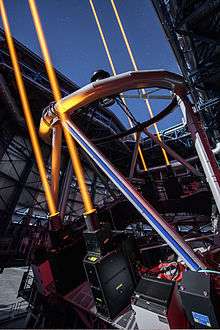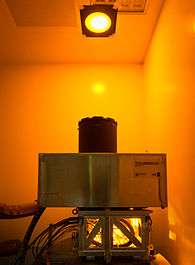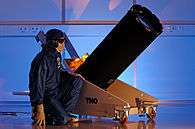Laser guide star

Laser guide star is an artificial star image created for use in astronomical adaptive optics imaging. Adaptive optics (AO) systems require a wavefront reference source in order to correct atmospheric distortion of light (called astronomical seeing). Sufficiently bright stars are not available in all parts of the sky, which greatly limits the usefulness of natural guide star adaptive optics. Instead, one can create an artificial guide star by shining a laser into the atmosphere. This star can be positioned anywhere the telescope desires to point, opening up much greater amounts of the sky to adaptive optics.
Because the laser beam is deflected by astronomical seeing on the way up, the returning laser light does not move around in the sky as astronomical sources do. In order to keep astronomical images steady, a natural star nearby in the sky must be monitored in order that the motion of the laser guide star can be subtracted using a tip–tilt mirror. However, this star can be much fainter than is required for natural guide star adaptive optics because it is used to measure only tip and tilt, and all higher-order distortions are measured with the laser guide star. This means that many more stars are suitable, and a correspondingly larger fraction of the sky is accessible.
Types
There are two main types of laser guide star system, known as sodium and Rayleigh beacon guide stars.
Sodium beacons are created by using a laser tuned to 589.2 nanometers to energize atoms in the sodium layer of the mesosphere at an altitude of around 90 km (56 mi). The sodium atoms then re-emit the laser light, producing a glowing artificial star. The same atomic transition of sodium is used in sodium-vapor lamps for street lighting.
Rayleigh beacons rely on the scattering of light by the molecules in the lower atmosphere. In contrast to sodium beacons, Rayleigh beacons are much simpler and less costly, but do not provide as good a wavefront reference, since the artificial beacon is generated much lower in the atmosphere. The lasers are often pulsed, with measurement of the atmosphere being time-gated (taking place several microseconds after the pulse has been launched, so that scattered light at ground level is ignored and only light that has traveled for several microseconds high up into the atmosphere and back is actually detected).
Progress
Laser guide star adaptive optics is still a very young field, with much effort currently invested in technology development. As of 2006, only two laser guide star AO systems were regularly used for science observations and have contributed to published results in peer-reviewed scientific literature: those at the Lick and Palomar Observatories in California, and the Keck Observatory in Hawaii. However, laser guide star systems were under development at most major telescopes, with the William Herschel Telescope, Very Large Telescope and Gemini North having tested lasers on the sky but not yet achieved regular operations. Other observatories developing laser AO systems as of 2006 include the Large Binocular Telescope and Gran Telescopio Canarias. The laser guide star system at the Very Large Telescope started regular scientific operations in June 2007.[4]
Dye lasers played, and continue to play, a significant role in the development of laser guide stars.[5][6][7][8][9][10] However, the use of fluid gain media is considered by some as disadvantageous.[11] Second generation laser sources for sodium guide star applications include sum-frequency-mixed solid-state lasers .[12] New third generation laser systems based on tunable diode lasers with subsequent narrow-band Raman fiber amplification and resonant frequency conversion have been under development since 2005. Since 2014 fully engineered systems are commercially available.[13] Important output features of the tunable lasers mentioned here include diffraction-limited beam divergence and narrow-linewidth emission.

Since April 2016,[14] the 4 Laser Guide Star Facility (4LGSF) has been installed at the ESO’s Very Large Telescope (VLT),[15] as a new subsystem of the Adaptive Optics Facility (AOF).[16] The 4LGSF is a complement of the VLT Laser Guide Star Facility (LGSF). Instead of a single laser beam, the 4LGSF propagates four laser beams into the skies of Paranal, in northern Chile, producing four artificial stars by illuminating sodium atoms located in the atmosphere at 90 km altitude. Each laser delivers 22 watts in a diameter of 30 cm (12 in). The 4LGSF Laser System is based on a fiber Raman laser technology, developed at ESO and transferred to industry.[17][18] The upgrade to four lasers with fiber Raman laser technology is necessary to support the new instruments at Paranal Observatory,[19] like HAWK-I (with GRAAL) [20] and MUSE (with GALACSI).[21] Also with the 4LGSF the stability is increased, the amount of preventative maintenance support and the preparation of an observing run time will be considerably reduced compared to the LGSF, which currently uses still its original dye laser (planned to be replaced by a fiber laser). The 4LGSF helps astronomers to test devices for the E-ELT,[22] which will have a similar system to support the adaptive optics of the telescope. Given its power, the 4LGSF operations follow a protocol to avoid any risk. The laser system is equipped with an automatic aircraft avoidance system that shuts down the lasers if an aircraft ventures too close to the beams.
References
- ↑ "Laser Meets Lightning". ESO Picture of the Week. European Southern Observatory.
- ↑ "Powerful New Laser Passes Key Test". ESO. Retrieved 2 April 2014.
- ↑ "VLT's New Laser Launchers Arrive at ESO". ESO Announcement. Retrieved 22 February 2012.
- ↑ Markus Kasper; Stefan Stroebele; Richard Davies; Domenico Bonaccini Calia (13 June 2007). "Free from the Atmosphere – Laser Guide Star System on ESO's VLT Starts Regular Science Operations". ESO for the public. ESO. Retrieved 2 June 2011.
- ↑ Everett, Patrick N. (1989). "300-Watt dye laser for field experimental site". Proceedings of the International Conference on Lasers '88: 404–9. Bibcode:1989lase.conf..404E. OCLC 20243203. OSTI 5416850.
- ↑ Primmerman, Charles A.; Murphy, Daniel V.; Page, Daniel A.; Zollars, Byron G.; Barclay, Herbert T. (1991). "Compensation of atmospheric optical distortion using a synthetic beacon" (PDF). Nature. 353 (6340): 141–3. Bibcode:1991Natur.353..141P. doi:10.1038/353141a0.
- ↑ Bass, Isaac L.; Bonanno, Regina E.; Hackel, Richard P.; Hammond, Peter R. (1992). "High-average-power dye laser at Lawrence Livermore National Laboratory". Applied Optics. 31 (33): 6993–7006. Bibcode:1992ApOpt..31.6993B. doi:10.1364/AO.31.006993. PMID 20802559.
- ↑ Duarte, F. J. (2001). "Multiple-Return-Pass Beam Divergence and the Linewidth Equation". Applied Optics. 40 (18): 3038–41. Bibcode:2001ApOpt..40.3038D. doi:10.1364/AO.40.003038. PMID 18357323.
- ↑ Pique, Jean-Paul; Farinotti, Sébastien (2003). "Efficient modeless laser for a mesospheric sodium laser guide star". Journal of the Optical Society of America B. 20 (10): 2093–101. Bibcode:2003OSAJB..20.2093P. doi:10.1364/JOSAB.20.002093.
- ↑ Wizinowich, Peter L.; Le Mignant, David; Bouchez, Antonin H.; Campbell, Randy D.; Chin, Jason C. Y.; Contos, Adam R.; Van Dam, Marcos A.; Hartman, Scott K.; et al. (2006). "The W. M. Keck Observatory Laser Guide Star Adaptive Optics System: Overview" (PDF). Publications of the Astronomical Society of the Pacific. 118 (840): 297–309. Bibcode:2006PASP..118..297W. doi:10.1086/499290.
- ↑ Comaskey, Brian; Ault, Earl; Kuklo, Thomas (Nov 6, 2003), High average power laser gain medium with low optical distortion using a transverse flowing liquid host, retrieved 2016-03-19
- ↑ Reference needed
- ↑ "SodiumStar 20/2 - High Power CW Tunable Guide Star Laser" (PDF). www.toptica.com. TOPTICA Photonics AG. Retrieved 20 August 2015.
- ↑ "Four Lasers Over Paranal". European Southern Observatory. Retrieved 27 April 2016.
- ↑ "Very Large Telescope – The world's most advanced visible-light astronomical observatory". European Southern Observatory.
- ↑ "Adaptive Optics". European Southern Observatory.
- ↑ "ESO Signs Technology Transfer Deal". ESO announcement.
- ↑ "Laser Guide Star Units Accepted and Shipped to Chile". ESO announcement.
- ↑ "Very Large Telescope – The world's most advanced visible-light astronomical observatory". European Southern Observatory.
- ↑ "HAWK-I – High Acuity Wide-field K-band Imager". European Southern Observatory.
- ↑ "MUSE – Multi Unit Spectroscopic Explorer". European Southern Observatory.
- ↑ "The European Extremely Large Telescope – The world's biggest eye on the sky". European Southern Observatory.
External links
| Wikimedia Commons has media related to Laser guide star. |
- ESOcast 34: How To Stop a Star's Twinkle
- ESO’s New Compact Laser Guide Star Unit Tested
- Gemini's Laser Vision Reveals Striking New Details in Orion Nebula


